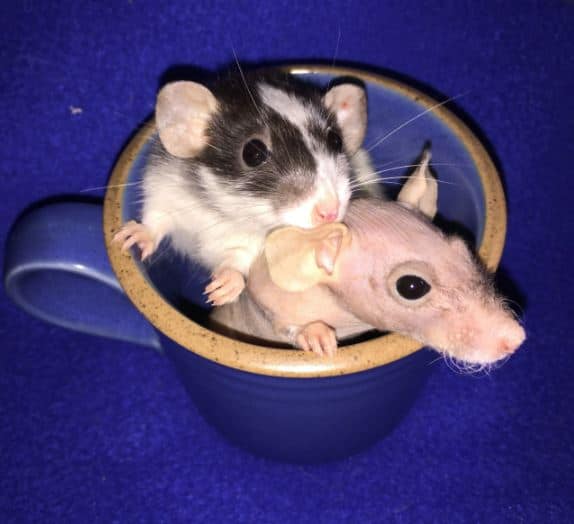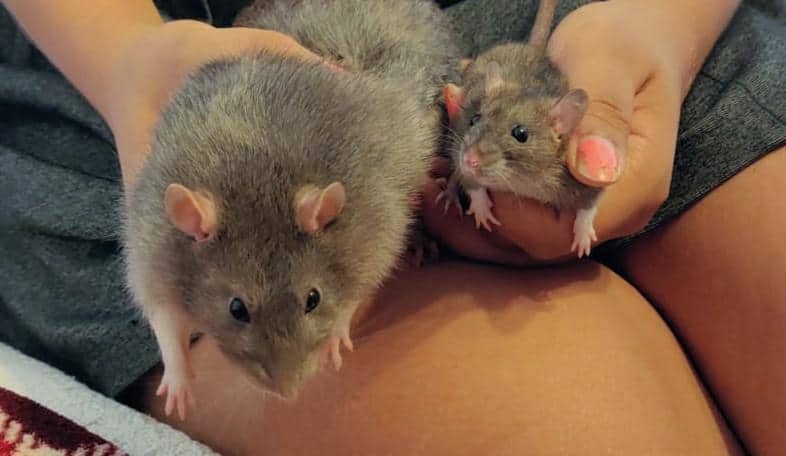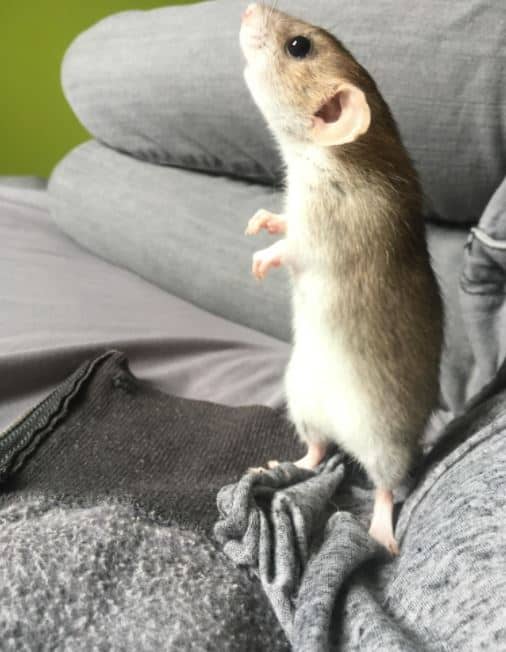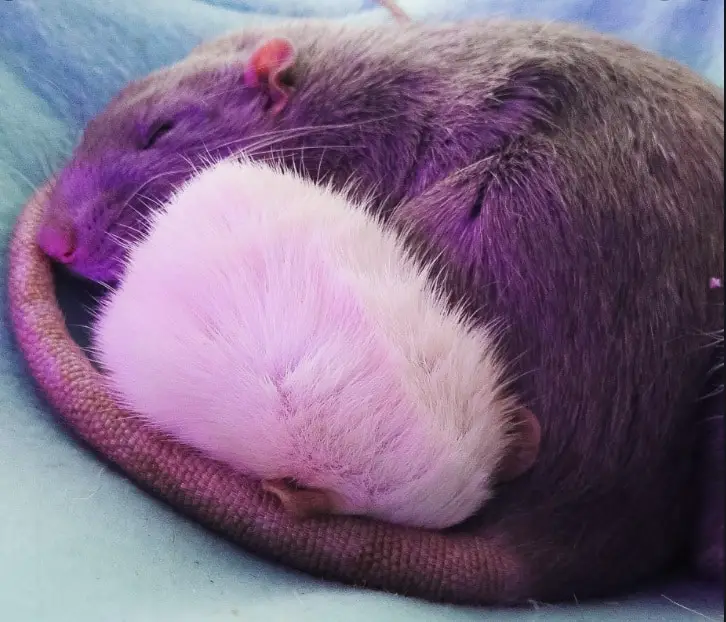Pet rats come in many different types and colors, and some rat types are more well-known than others. Today, we’re going to take the smallest kind of rat under the microscope: the dwarf rat.
Many people mistake small rats for dwarf rats, and many owners of small rats wonder whether their rat is a dwarf. In order to clear the confusion and misconceptions, this guide will contain all the information you need about dwarf rats. I will discuss how you can tell a dwarf rat apart from a standard rat, the care they require, its lifespan, where to buy one, and more. Let’s dig in!

What is a dwarf rat?

Dwarf rats are small, but just because you have a rat that’s smaller than average does not necessarily mean that you have a dwarf rat. In order for a rat to be classified as a dwarf, it has to carry and display the recessive dwarf gene. The dwarf gene causes a reduction in growth hormone, which results in rats that are much smaller than usual. Usually, they’re 40 to 75% smaller than a regular fully grown rat, which is only slightly larger than some fancy mice! Fully grown, male and female dwarf rats weigh around 100 grams, while standard rats weigh between 250-450 grams (female) and 450-650 grams (male).
Here’s an interesting video that compares 3-week-old dwarfs to standard rats:
For the rest, dwarf rats look almost the same as standard rats, but there are a few ways to tell them apart. For instance, dwarf rats typically have bigger eyes in relation to their body, a shorter and thinner tail, and a different head shape.
Since the dwarf gene is recessive, it’s possible for rats to carry the gene, but not display it. This is called being a hereditary carrier. This basically means that you can have a rat that has the dwarf gene but is of regular size. If you breed two rats that both carry the gene but do not display it, about 25% of the litter will display the gene. In order to guarantee that the entire litter will carry and display the gene, you have to breed two rats that display the gene together.
The first recorded dwarf rat in history was found in a laboratory colony in 1977. Interestingly enough, experiments have been done on dwarf rats which have shown that they are more resistant to certain forms of cancer. The reason for this is that they have much lower amounts of growth hormone, which prevents tumors from growing.

The temperament of dwarf rats
The temperament of dwarf rats is usually not all that different than that of other types of rats. They can form strong bonds with their owners, love to play, and are very sociable animals that make great pets. However, there have been reports that dwarf rats are more active than standard rats. Of course, just like standard rats, dwarf rats also have their own distinct personalities, so no two rats will be the same. It’s possible that your particular dwarf rat is very active, while another dwarf rat is more laid back and relaxed.
On the whole, dwarf rats have an affectionate, energetic, and sweet temperament that most rat owners fall in love with.
Do dwarf rats require special care?
The care that dwarf rats require is very similar to that of standard rats. They need the same bedding, treats, enclosure, companionship, and toys. Some people believe that because they are smaller, they need a smaller cage, but this is not true.
However, since they are smaller, they do need less food. Still, while dwarf rats require less food than standard rats, the types of food they can and should eat are the same. The ideal diet of any rat consists of 80% pellets, and 20% fresh fruits and vegetables. To learn more about what to feed your dwarf rat, I suggest checking out my rat nutrition guide.

The lifespan of a dwarf rat
While many people assume that dwarf rats have a shorter lifespan than standard rats, the opposite is actually true. A study in the Experimental Gerontology journal showed that dwarf rats have a lifespan that’s 38% longer than the lifespan of standard rats! This means that while a standard rat has an average lifespan of 2 to 3 years, the dwarf rat has a lifespan of 2.75 to 4 years.
One of the main reasons why dwarf rats have a longer lifespan than standard rats is that they suffer less from oxidative damage and oxidative stress in the liver, kidney, and lungs, in addition to being less prone to tumors than standard rats.
Can dwarf rats live with standard rats?
Yes, dwarf rats and standard rats typically get along well and can live in the same cage. Also, just like standard rats, dwarf rats should not be kept in solitude. Rats are social animals and become unhappy when they live alone. Always make sure that your rat has friends to play and socialize with.

Buying a dwarf rat
Finding a dwarf rat in a pet shop is often difficult. Fortunately, many ratteries have dwarf rat lines available for purchase.
If you’re looking to buy a dwarf rat, try one of these ratteries:
Usually, dwarf rats are more expensive than standard rats, simply because they are more difficult to breed and thus rarer. The average price of a dwarf rat from a reputable breeder, such as one of the ones mentioned above, is about $100, which is quite a bit more than the price of a standard rat.
In addition, since dwarfs are harder to breed and often in high demand, you will sometimes be put on a waitlist.
Precautions when buying a dwarf rat
When buying a dwarf rat, it’s important that you make sure that the rat you’re buying is actually a dwarf and not simply runt of the litter. Runts are not dwarf rats (they do not have the dwarf rat gene) and usually have stunted growth and often have several health problems. Because of this, it’s important to make sure that when you’re looking to buy a dwarf rat, that the rat you’re buying is actually a dwarf. If not, you might accidentally buy a rat that is in poor health. To avoid this, it’s important to buy from a reputable breeder.

Wrapping up
So, if you’ve always wished that your pet rat would stay the same size as when you first got him, a dwarf rat might be a great choice as your next pet! They stay small, are healthy, and typically even live longer than standard rats! Because of their inquisitive, intelligent, and affectionate nature they’re great as pets and their small size makes them extra cute to boot, what’s not to love?
- How Long Do American Eskimo Dogs Live? Important Factors and Care Tips - September 29, 2023
- Do American Bulldogs Need Grooming? Essential Tips and Care Guidelines - September 29, 2023
- Do Bengal Cats Enjoy Playing? Essential Tips for Keeping Them Active - September 29, 2023